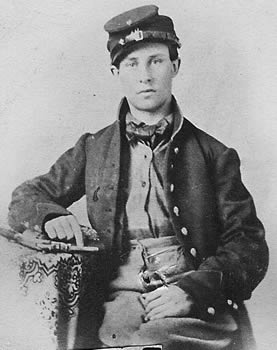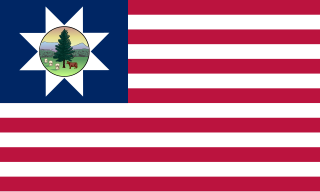
Robert Edward Lee was a Confederate general during the American Civil War, toward the end of which he was appointed the overall commander of the Confederate States Army. He led the Army of Northern Virginia—the Confederacy's most powerful army—from 1862 until its surrender in 1865, earning a reputation as a skilled tactician.

Arlington County, or simply Arlington, is a county in the U.S. state of Virginia. The county is located in Northern Virginia on the southwestern bank of the Potomac River directly across from Washington, D.C., the national capital.
Johnny Reb is the national personification of the common soldier of the Confederacy. During the American Civil War and afterwards, Johnny Reb and his Union counterpart Billy Yank were used in speech and literature to symbolize the common soldiers who fought in the Civil War in the 1860s. The symbolic image of Johnny Reb in Southern culture has been represented in its novels, poems, art, public statuary, photography, and written history. According to the historian Bell I. Wiley, who wrote about the common soldiers of the Northern and the Southern armies, the name appears to have its origins in the habit of Union soldiers calling out, "Hello, Johnny" or "Howdy, Reb" to Confederate soldiers on the other side of the picket line.

Billy Yank or Billy Yankee is the personification of the United States soldier during the American Civil War. The latter part of the name is derived from Yankee, previously a term for New Englanders, and possibly deriving from a term for Dutch settlers of New Netherland before that, extended by American Southerners to refer to Americans from above the Mason-Dixon Line. Although little evidence exists to suggest that the name was used widely during the Civil War, unlike its rebel counterpart Johnny Reb, early 20th century political cartoonists introduced 'Billy Yank' to symbolize U.S. combatants in the American Civil War of the 1860s.

James Lawson Kemper was a lawyer, a Confederate general in the American Civil War, and the 37th Governor of Virginia. He was the youngest brigade commander and only non-professional general officer in the division that led Pickett's Charge, during which he was severely wounded.

Alexander Gardner was a Scottish photographer who immigrated to the United States in 1856, where he began to work full-time in that profession. He is best known for his photographs of the American Civil War, U.S. President Abraham Lincoln, and of the conspirators and the execution of the participants in the Lincoln assassination plot.
Johnny Reb or Johnny Rebel is a slang term for Confederate soldiers in the American Civil War.

The 3rd Vermont Infantry Regiment was a three-years infantry regiment in the Union Army during the American Civil War. It served in the eastern theater, predominantly in the VI Corps, Army of the Potomac, from July 1861 to July 1865. It was a member of the Vermont Brigade.
The 134th Pennsylvania Volunteer Infantry was an infantry regiment in the Union Army during the American Civil War.

John Rogers Cooke was a Confederate general during the American Civil War. He was the son of Union general Philip St. George Cooke and the brother-in-law of Confederate cavalry leader Jeb Stuart.
Johnny Reb and Billy Yank is a novel first published in 1905 by Alexander Hunter, a Confederate soldier who served in the 17th Virginia Infantry and the 4th Virginia Cavalry from 1861 to 1865. The novel is noted for encapsulating most of the major events of the American Civil War, due to Hunter's involvement in the war.

Fort Corcoran was a wood-and-earthwork fortification constructed by the Union Army in northern Virginia as part of the defenses of Washington, D.C. during the American Civil War. Built in 1861, shortly after the occupation of Arlington, Virginia by Union forces, it protected the southern end of the Aqueduct Bridge and overlooked the Potomac River and Theodore Roosevelt Island, known as Mason's Island.

Cyrus B. Lower was a United States soldier who fought with the Union Army during the American Civil War as a private in the 13th Pennsylvania Reserve Regiment. He received his nation's highest award for valor, the U.S. Medal of Honor, for his display of gallantry during the Battle of the Wilderness on May 7, 1864, and afterward when he rejoined his regiment after having been wounded in action and held as a prisoner of war by Confederate States Army troops. That award was conferred on July 20, 1887.

The 8th Virginia Infantry Regiment was a Confederate infantry regiment raised by Colonel Eppa Hunton in Leesburg, Virginia on May 8, 1861. The unit comprised six companies from Loudoun, two companies from Fauquier, one company from Fairfax and one company from Prince William. Initial regimental officers included: Lt. Colonel Charles B. Tebbs, Major Norborne Berkeley, John M. Orr - Quartermaster, Dr. Richard H. Edwards - Surgeon, Charles F. Linthicum - Chaplain. After Eppa Hunton's promotion to brigadier general in August 1863, in part based on his valor during the Battle of Gettysburg, particularly during Pickett's Charge, Norborne Berkeley was promoted to command the 8th Virginia, and his brother Edmund became the Lieut. Colonel, his brother William Berkeley, Major, and Charles Berkeley became the senior Captain of what then became known as the "Berkeley Regiment." Nonetheless, Norborne, William and Charles Berkeley were all in Union prisoner of war camps and their brother Edmund still recovering from his Gettysburg wound on August 9.

Abingdon was an 18th- and 19th-century plantation owned by the prominent Alexander, Custis, Stuart, and Hunter families and worked at times by slaves. The plantation's site is now located in Arlington County in the U.S. state of Virginia.
The 30th Ohio Infantry Regiment was an infantry regiment in the Union Army during the American Civil War.
The 48th Regiment Pennsylvania Volunteer Infantry, the "Schuylkill Regiment", was an infantry regiment of the Union Army during the American Civil War.

The Norfolk Confederate Monument was a Confederate memorial in front of the Norfolk Southern Museum in Norfolk, Virginia, United States. The monument was removed in June 2020.

At Ready (1909) is a memorial of a Confederate soldier originally located in front of the Albemarle County Courthouse in downtown Charlottesville, Virginia. The statue, popularly known as "Johnny Reb," and accompanying objects were removed on September 12, 2020. The statue and nearby cannon, and cannonballs were removed to be placed on display at the Third Winchester Battlefield, part of the Shenandoah Valley Battlefields National Historic District.

The 28th Virginia battle flag is a Confederate battle flag that belonged to the 28th Virginia Infantry Regiment. Captured by the 1st Minnesota Infantry Regiment at the Battle of Gettysburg, the flag was brought to Minnesota and exhibited at the state's capitol for several years before passing into the permanent collection of the Minnesota Historical Society after 1896 where it has remained since. Although various groups in Virginia have requested that the flag be returned, beginning as early as 1960, Minnesota has repeatedly declined to return it, with Governor Jesse Ventura asking "Why? I mean, we won."














